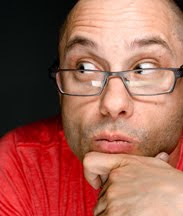At Blizzard, you have to paint a lot of gold. Fortunately there's a guy in Cinematics named Mathias Verhasselt (a.k.a."the computer") who can render the shit out of gold. And pretty much everything else.
This was my first attempt, under his stern tutelage.
Get this : gold apparently doesn't cast a shadow on itself. Mathias saw that I drew one [left] and said, flatly, "No, no, no. Get rid of that." Rather, gold starts out resembling a muted chrome and the yellowy-orangey warmth comes from highlights, ambient occlusion, and areas reflecting itself! As someone who's only thought about shadows up to this point, the idea of painting reflective anything boggles the mind. I guess this is what bounced light is, but still...
I'm going to keep trying, but it'll be a while before I can catch up to the computer!
This was my first attempt, under his stern tutelage.
Get this : gold apparently doesn't cast a shadow on itself. Mathias saw that I drew one [left] and said, flatly, "No, no, no. Get rid of that." Rather, gold starts out resembling a muted chrome and the yellowy-orangey warmth comes from highlights, ambient occlusion, and areas reflecting itself! As someone who's only thought about shadows up to this point, the idea of painting reflective anything boggles the mind. I guess this is what bounced light is, but still...
I'm going to keep trying, but it'll be a while before I can catch up to the computer!

7 comments:
Ohhh.. that makes so much sense!
From my limited experience of studying gold - and probably not nearly as much as m@:
Gold DOES on cast shadows, but in most lighting situations you wouldn't be able to tell because there are so many reflections even an area in cast shadow's values may get bumped up to the point where they are essentially blown out. But regardless:
http://leftoutside.files.wordpress.com/2009/07/turkmenbashi-gold-statue-crazy.jpg
http://saybrook.files.wordpress.com/2009/09/214302-gold-statue-02.jpg?w=300&h=225
In practical terms it's rare to see and for all intensive purposes 80 % of the time is unnecessary.
I think the key in most lighting situations for gold would be:
1. having a solid ambient occlusion 'map'
2. incredibly saturated terminator, most gold ornaments aren't too much of a gold hue in the highlight/specularity department, or in the shadows, the indication of it actually BEING gold is inferred mostly at the terminator
ie. http://i381.photobucket.com/albums/oo257/camelclub78/Oregon%20or%20Bust/Picture518.jpg in reality the light/shadow here is all pretty desaturated, but around where they meet is incredibly yellow-orange.
3. Keeping in mind what gold reflects well and why: http://upload.wikimedia.org/wikipedia/commons/9/9d/Image-Metal-reflectance.png
"Silver, gold and copper have similar electron configurations, but we perceive them as having quite distinct colors. Electrons absorb energy from incident light, and are excited from lower energy levels to higher, vacant energy levels. The excited electrons can then return to the lower energies and emit the difference of energy as a photon.
If an energy level (like the 3d band) holds many more electrons (than other energy levels) then the excitation of electrons from this highly occupied level to above the Fermi level will become quite important. Gold fulfills all the requirements for an intense absorption of light with energy of 2.3 eV (from the 3d band to above the Fermi level). The color we see is yellow, as the corresponding wavelengths are re-emitted. Copper has a strong absorption at a slightly lower energy, with orange being most strongly absorbed and re-emitted. In silver, the absorption peak lies in the ultraviolet region, at about 4 eV. As a result, silver maintains high reflectivity evenly across the visible spectrum, and we see it as a pure white. The lower energies (which in this case contain energies corresponding to the entire visible spectrum of color) are equally absorbed and re-emitted.
Silver and aluminum powders appear black because the white light that has been re-emitted is absorbed by nearby grains of powder and no light reaches the eye."
I never thought about that, but now I certainly will. Thanks for posting that.
See, I'll never be able to remember all that. At best, I'll have to come up with a clever shorthand involving aforementioned AO and gradient maps. Fuckin' GOLD, son!!!
Great post. I realize we're talking about very polished gold, but I'm curious why it wouldn't look a little more like this: http://i.telegraph.co.uk/telegraph/multimedia/archive/00797/kate-moss-gold-stat_797084c.jpg
very excellent post...Love Mathias' work...
P
I think it looks sick!
Post a Comment